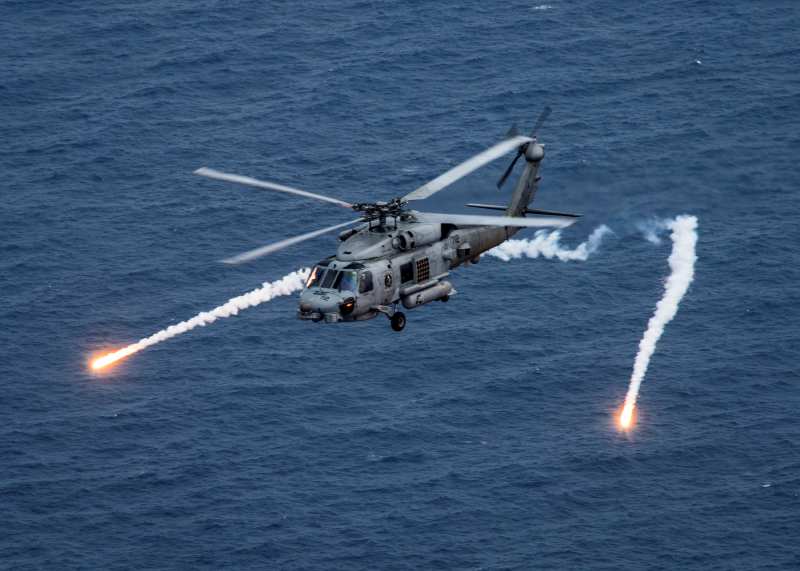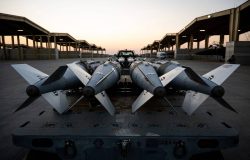
FILE PHOTO: A U.S. Navy MH-60R Sea Hawk helicopter from the “Blue Hawks” of Helicopter Maritime Strike Squadron 78 fires chaff flares during a training exercise near the aircraft carrier USS Carl Vinson (CVN 70) in the Philippine Sea April 24, 2017.
15:54 JST, May 5, 2022
TAIPEI (Reuters) – Taiwan signaled on Thursday that it had abandoned a plan to buy advanced new anti-submarine warfare helicopters from the United States, saying they were too expensive.
Taiwan had earlier said it was planning to buy 12 MH-60R anti-submarine helicopters, made by Lockheed Martin Corp LMT.N unit Sikorsky, but domestic media said the United States had rejected the sale as not being in line with the island’s needs.
Asked in parliament about recent changes to Taiwan’s purchases of new U.S. weapons, Defence Minister Chiu Kuo-cheng mentioned the helicopter case first.
“The price is too high, beyond the scope of our country’s ability,” he said.
Two other arms purchases have also been delayed – M109A6 Medium Self-Propelled Howitzer artillery systems, and mobile Stinger anti-aircraft missiles.Read full story
The Raytheon Technologies’ RTX.N Stingers are in hot demand in Ukraine, where they have been used against Russian aircraft, but U.S. supplies have shrunk and there are significant hurdles to producing more of the anti-aircraft weapons. Read full story
Chiu said they had already signed the contract for the Stingers and paid for them, and they would press the United States to deliver them.
“We don’t view arms sales as a trifling matter, and we have back-up plans,” he added, without elaborating.
Taiwan says the United States has offered it alternatives to the M109A6, including truck-based rocket launchers made by Lockheed Martin called the High Mobility Artillery Rocket System, or HIMARS.
Chiu said they were still considering their options on that.
Taiwan, claimed by China as its own territory, is undertaking a military modernisation program to improve its capabilities to fend off a Chinese attack, including with precision weapons like missiles.
President Tsai Ing-wen has championed the concept of “asymmetric warfare,” which involves developing high-tech, highly mobile weapons that are hard to destroy and can deliver precision attacks.
U.S. officials have been pushing Taiwan to modernize its military so it can become a “porcupine,” hard for China to attack.
China has been ramping up its own military modernisation and pressure against Taiwan as it seeks to force the democratically governed island to accept Beijing’s rule.
Chiu said the recently – he did not give a timeframe – there were many “enemy ships” in the waters around Taiwan, which “in principle stand off” with Taiwanese forces, though he did not give details.
Eight Chinese naval vessels, including the aircraft carrier the Liaoning, passed between islands in Japan’s southern Okinawa chain on Monday, an area that is to Taiwan’s northeast.
"News Services" POPULAR ARTICLE
-

American Playwright Jeremy O. Harris Arrested in Japan on Alleged Drug Smuggling
-

Japan’s Nikkei Stock Average as JGB Yields, Yen Rise on Rate-Hike Bets
-

Japan’s Nikkei Stock Average Licks Wounds after Selloff Sparked by BOJ Hike Bets (UPDATE 1)
-

Japanese Bond Yields Zoom, Stocks Slide as Rate Hike Looms
-

Japan’s Nikkei Stock Average Buoyed by Stable Yen; SoftBank’s Slide Caps Gains (UPDATE 1)
JN ACCESS RANKING
-

Keidanren Chairman Yoshinobu Tsutsui Visits Kashiwazaki-Kariwa Nuclear Power Plant; Inspects New Emergency Safety System
-

Imports of Rare Earths from China Facing Delays, May Be Caused by Deterioration of Japan-China Relations
-

University of Tokyo Professor Discusses Japanese Economic Security in Interview Ahead of Forum
-

Japan Pulls out of Vietnam Nuclear Project, Complicating Hanoi’s Power Plans
-

Govt Aims to Expand NISA Program Lineup, Abolish Age Restriction























